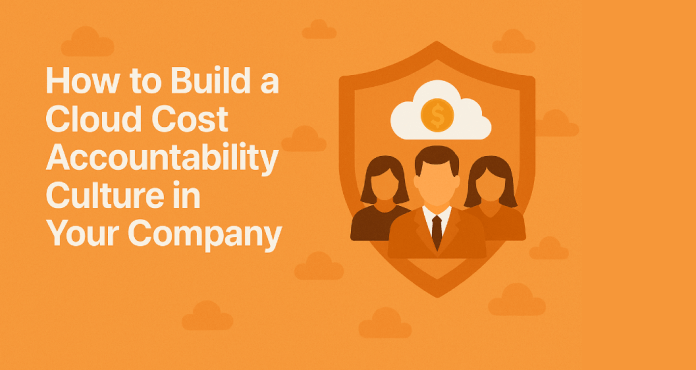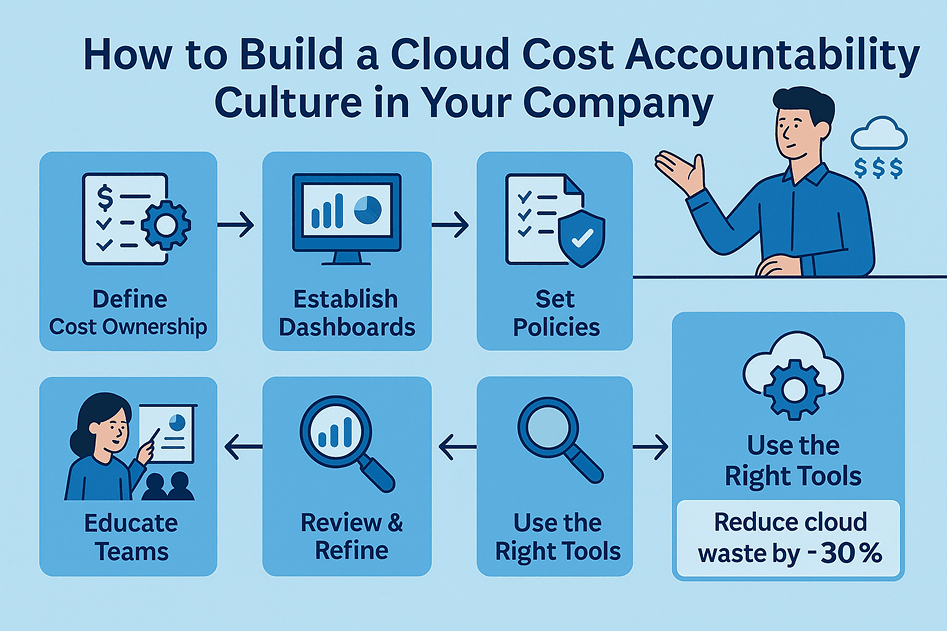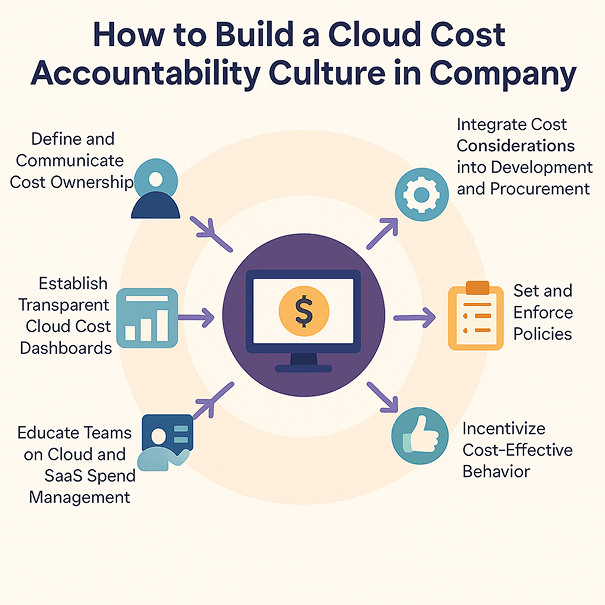
As organizations increasingly rely on cloud and SaaS platforms to run their operations, managing costs effectively has become more critical than ever. While automation and visibility tools can help, the real differentiator lies in building a culture of accountability around cloud cost management. Without a cultural shift, even the most advanced tools won’t prevent overspending.
This article will walk you through the steps to instill cloud cost accountability in your organization and highlight how tools like Binadox can support your efforts.
Why Cloud Cost Accountability Matters
Another important reason to promote cloud cost accountability is the increasing complexity of multi-cloud environments. Organizations often juggle services from AWS, Azure, and Google Cloud, alongside dozens of SaaS apps. This fragmented structure can obscure visibility, making cost tracking and optimization harder without strong accountability frameworks in place. By promoting cost responsibility at every level, companies can confidently embrace multi-cloud strategies while minimizing waste and improving performance.
Cloud computing offers unparalleled scalability and flexibility. But with freedom comes financial risk. Unused instances, lack of governance, and shadow IT can rapidly escalate costs. Establishing a cost accountability culture helps:
- Prevent unnecessary cloud and SaaS expenses.
- Improve budget forecasting and financial planning.
- Align IT spending with business value.
- Increase collaboration between technical and financial teams.
Furthermore, when accountability is ingrained at every level, companies benefit from faster decision-making, reduced compliance risks, and stronger performance tracking. In today’s fast-paced digital environment, the ability to align cloud usage with financial discipline is not just a best practice—it’s a competitive advantage.

1. Define and Communicate Cost Ownership
Ownership isn’t just about assigning names—it’s about embedding responsibility into workflows. When teams understand their role in cost management, they are more likely to adopt efficient provisioning, delete idle resources, and avoid scope creep. Over time, this behavior becomes second nature and drives cumulative cost savings.
The first step is assigning ownership. Every resource, whether SaaS subscription or cloud instance, should have a clear owner responsible for its usage and cost.
Tips:
- Tag cloud resources with owner names, departments, or projects.
- Use a platform like Binadox to automate tagging and visualize spend by team or location.
- Set expectations with department heads to regularly review and justify their cloud usage.
Without defined ownership, it becomes easy for costs to balloon without accountability. Assigning responsible stakeholders fosters proactive engagement, creating a culture where cost-efficiency is part of everyday decision-making.
2. Establish Transparent Cloud Cost Dashboards
Dashboards should be accessible to both technical and financial stakeholders. By integrating these dashboards into regular business reviews or sprint planning sessions, organizations encourage cost-conscious thinking across all levels. When cost data becomes a part of daily conversations, accountability naturally follows.
Transparency fuels accountability. Create dashboards that provide real-time visibility into cloud and SaaS costs at all organizational levels.
Binadox Advantage:
Binadox offers centralized dashboards that show:
- Cloud and SaaS spend by team, region, or product.
- Underutilized and abandoned subscriptions.
- Cost anomalies and rightsizing opportunities.
Transparent dashboards not only build trust but also drive ownership by giving teams the tools they need to monitor and act on their spending. They provide clarity and direction for strategic budgeting conversations and cost optimization efforts.
3. Integrate Cost Considerations into Development and Procurement
Procurement teams should work closely with IT and department leaders to assess true business needs before signing contracts. Additionally, cost estimation should be part of the architecture design process. Including pricing calculators or cost simulations during planning can help avoid surprises after deployment.
Cost responsibility isn’t just for finance—it should be part of how developers deploy resources and how procurement teams evaluate new tools.
Best Practices:
- Include cost implications in DevOps workflows.
- Integrate approval policies for SaaS subscriptions via centralized procurement systems.
- Evaluate alternatives regularly to avoid overpaying for overlapping solutions.
Embedding cost awareness into software delivery pipelines ensures more deliberate and informed cloud usage. By integrating financial insights into everyday workflows, organizations avoid waste while ensuring their infrastructure scales efficiently with growth.
4. Educate Teams on Cloud and SaaS Spend Management
Regular training sessions can include real-life examples of cost-saving strategies, such as consolidating duplicate SaaS tools or identifying abandoned resources. Consider assigning ‘cost champions’ in each department to keep awareness high and serve as liaisons with finance or IT teams.
You can’t expect accountability without education. Run workshops and provide materials that explain:
- How cloud billing works.
- What contributes to SaaS waste (e.g., unused licenses).
- How to use tools like Binadox for monitoring and optimization.
Knowledge empowers teams to take responsibility for the resources they use. When employees understand how their behavior impacts costs, they’re more likely to adopt smart practices that align with company-wide goals.
5. Set and Enforce Policies
Good policy enforcement also relies on clear communication. Employees must understand the “why” behind policies to comply willingly. Periodic reminders and simple, well-documented procedures can go a long way in encouraging adherence. Transparency and fairness in policy enforcement also build trust and long-term engagement.
Policies turn good intentions into consistent action.
Examples:
- Require approval for new SaaS subscriptions.
- Mandate tagging of cloud resources.
- Automatically deactivate unused licenses after X days.
Using Binadox, companies can implement and enforce such policies through automation rules and alerts. Governance is the backbone of accountability, helping to reduce chaos and streamline decision-making.
6. Incentivize Cost-Effective Behavior
Creating internal case studies that highlight success stories can further reinforce good behavior. When teams see the real business impact of their efforts—like freeing up budget for innovation or avoiding layoffs during downturns—they’re more likely to stay engaged and cost-conscious.
Recognize departments and teams that effectively manage their budgets. Celebrate wins like:
- Reducing costs through rightsizing.
- Consolidating redundant tools.
- Cancelling unused subscriptions.
Incentives can take many forms—from internal recognition to budget flexibility—and they reinforce the value of proactive cost management. Over time, this recognition fosters a positive feedback loop where teams are motivated to continually optimize.
7. Review and Refine Regularly
Additionally, encourage departments to run self-assessments on their resource usage. This empowers them to proactively improve before central audits and builds a continuous feedback loop of improvement. Automation tools can further streamline this process and surface insights quickly.
Building a cost accountability culture is not a one-time event. It requires continuous refinement as your cloud and SaaS environments evolve.
Review Points:
- Monthly audits of cloud and SaaS spend.
- Regular updates to governance policies.
- Adjusting alerts and automation rules in platforms like Binadox.
Consistency in these reviews allows your organization to stay agile and cost-conscious, especially as business needs and technologies shift. Treat cost governance as a living strategy that adapts to market and organizational changes.

Start with the Right Tools
Beyond visualization, tools like Binadox can help standardize procurement workflows, flag compliance issues, and integrate alerts with Slack, Teams, or email to ensure stakeholders never miss critical cost signals. These capabilities strengthen organizational cost awareness and responsiveness.
Culture change is human, but it needs the right technical foundation. Binadox helps companies:
- Discover and monitor all SaaS and cloud assets.
- Track usage and costs in real time.
- Automate renewals and cost-saving actions.
- Centralize spend data for actionable insights.
Final Thoughts
As businesses evolve, maintaining financial agility is key. By making cost accountability a foundational element of company culture, you prepare your teams to adapt quickly, innovate freely, and scale efficiently without losing financial control. This is essential in today’s era of rapid digital transformation.
A cloud cost accountability culture empowers every team to think financially. It encourages collaboration, promotes efficiency, and protects your bottom line. With leadership buy-in, the right processes, and tools like Binadox, your company can turn cloud cost management into a competitive advantage.

